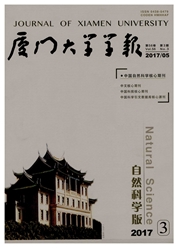

 中文摘要:
中文摘要:
为了研究人参皂甙Rg1对人成骨肉瘤MG--63细胞(以下简称“MG-63细胞”)形态与超微结构及终末分化指标的影响,鉴定其对MG63细胞的诱导分化作用.以50μg/mL人参皂甙Rg1处理MG63细胞,光学显微镜与电子显微镜观察MG-63细胞形态、超微结构变化。免疫细胞化学方法检测成骨细胞相关终末分化蛋白的表达变化。并同步以HMBA处理MG-63细胞作为阳性对照.光学显微镜与电子显微镜观察结果显示细胞形态与超微结构产生了细胞形态规则、大小一致、细胞铺展体积增大,核质比例减小、核内核仁数目减少、细胞器丰富发达等与正常细胞相似的恢复性变化.观察到MG63细胞终末分化指标Ⅰ型胶原、骨粘素、骨钙蛋白的阳性表达及钙化糖原颗粒的增多与典型骨节结的形成,其变化结果与HMBA处理细胞类似.本研究证实人参皂甙Rg1能显著改变MG-63细胞形态与超微结构恶性特征,并增强成骨细胞相关的终末分化指标的表达。从而对Mp63细胞的终末分化具有一定的诱导作用.
 英文摘要:
英文摘要:
To investigate the biological effects of ginsenoside Rg1, the human osteosarcoma MG-63 cells, which were treated with 50 μg/mL ginsenoside Rg1, were subjected to immuncocytochemical assay,light and electro-microscopy. The cells treated with hexamethylene bisacetamide were also investigated as positive control of induced differentiation. It was found by light and electro-microscopy that the configuration and ultrastructure of MG-63 had undergone restorational changes similar to that of normal cells after ginsenoside Rg1 treatments. The observed results are as follows: the morphology of the cells were regular and inclined to the same volume. The cells tended to be flat and spread, the size increased, the nucleo-cytoplasm ratio lessened, the number and size of nucleous decreased, the organelle were well-developed, typical and polarized.. Immunocytochemistry analysis revealed that the expression of the molecular biomarkers of terminal differentiation such as osteocalcin,osteonectin and calcified glycogen particles were strongly upregulated compared with the control groups. The calcified hepatin granules increased and the tybical bone nodules were obsreved in the ginsenoside Rg1 treated cells. From these we can confirm that cinnamic acid could reverse the malignant phenotypes of MG-63 cells, promote the expression of terminal differentiational biomarkers,and induce cell into terminal differentiation.
 同期刊论文项目
同期刊论文项目
 同项目期刊论文
同项目期刊论文
 期刊信息
期刊信息
